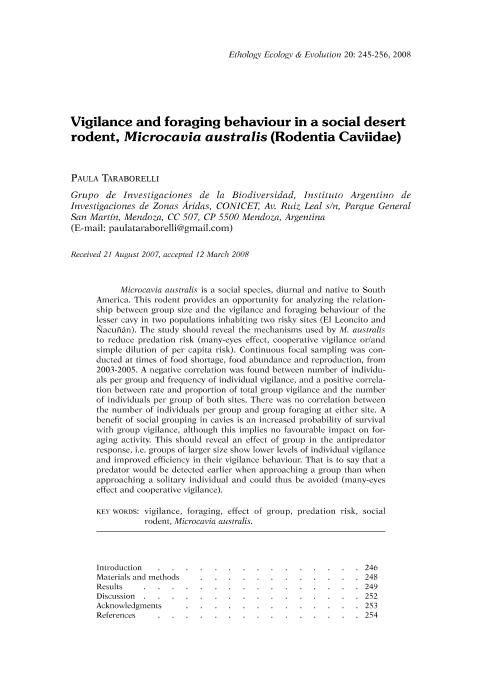Artículo
Vigilance and foraging behaviour in a social desert rodent, microcavia australis (rodentia caviidae)
Fecha de publicación:
12/2008
Editorial:
Universita Degli Studi Di Firenze
Revista:
Ethology Ecology & Evolution
ISSN:
0394-9370
Idioma:
Inglés
Tipo de recurso:
Artículo publicado
Clasificación temática:
Resumen
Microcavia australis is a social species, diurnal and native to South America. This rodent provides an opportunity for analyzing the relationship between group size and the vigilance and foraging behaviour of the lesser cavy in two populations inhabiting two risky sites (El Leoncito and Ñacuñán). The study should reveal the mechanisms used by M. australis to reduce predation risk (many-eyes effect, cooperative vigilance or/and simple dilution of per capita risk). Continuous focal sampling was conducted at times of food shortage, food abundance and reproduction, from 2003–2005. A negative correlation was found between number of individuals per group and frequency of individual vigilance, and a positive correlation between rate and proportion of total group vigilance and the number of individuals per group of both sites. There was no correlation between the number of individuals per group and group foraging at either site. A benefit of social grouping in cavies is an increased probability of survival with group vigilance, although this implies no favourable impact on foraging activity. This should reveal an effect of group in the antipredator response, i.e. groups of larger size show lower levels of individual vigilance and improved efficiency in their vigilance behaviour. That is to say that a predator would be detected earlier when approaching a group than when approaching a solitary individual and could thus be avoided (many-eyes effect and cooperative vigilance).
Archivos asociados
Licencia
Identificadores
Colecciones
Articulos(IADIZA)
Articulos de INST. ARG DE INVEST. DE LAS ZONAS ARIDAS
Articulos de INST. ARG DE INVEST. DE LAS ZONAS ARIDAS
Citación
Taraborelli, Paula Andrea; Vigilance and foraging behaviour in a social desert rodent, microcavia australis (rodentia caviidae); Universita Degli Studi Di Firenze; Ethology Ecology & Evolution; 20; 3; 12-2008; 245-256
Compartir
Altmétricas




